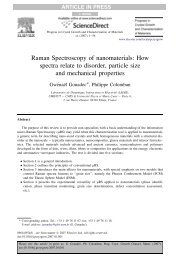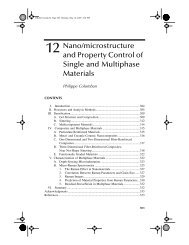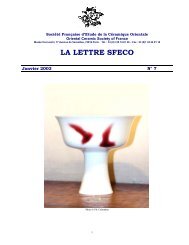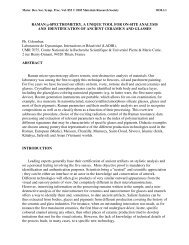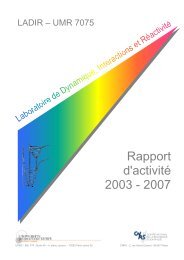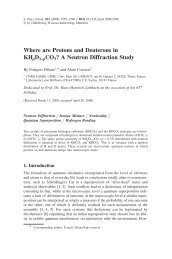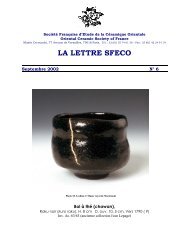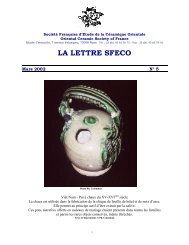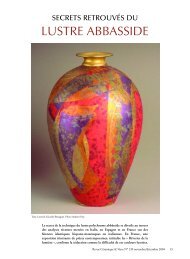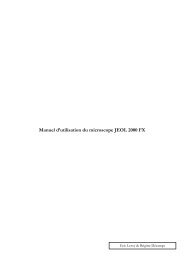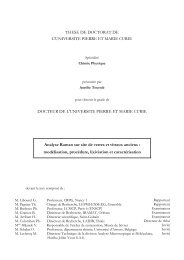Structure and dynamics of the symmetric hydrogen ... - ResearchGate
Structure and dynamics of the symmetric hydrogen ... - ResearchGate
Structure and dynamics of the symmetric hydrogen ... - ResearchGate
Create successful ePaper yourself
Turn your PDF publications into a flip-book with our unique Google optimized e-Paper software.
402( )F. Fillaux et al.rChemical Physics 244 1999 387–403driven by collisions with <strong>the</strong> molecules <strong>of</strong> <strong>the</strong> solvent.Momentum transferred to <strong>the</strong> proton parallel to<strong>the</strong> <strong>hydrogen</strong> bond Ž Q .H 5 is needed for <strong>the</strong> excitation<strong>of</strong> <strong>the</strong> stretching mode whilst <strong>the</strong> rotation <strong>of</strong> <strong>the</strong>carboxylic groups requires momentum transfer to <strong>the</strong>oxygen atoms Ž Q , Fig. 10 .O H . Therefore, energy<strong>and</strong> momentum must be transferred to <strong>the</strong> H <strong>and</strong> Oatoms independently <strong>and</strong> simultaneously, within <strong>the</strong>very short life time <strong>of</strong> vibrational excited statesŽy11-10 s .. The interconversion rate at a giventemperature depends on <strong>the</strong> distribution <strong>of</strong> kineticmomentum in <strong>the</strong> solution <strong>and</strong> thus on <strong>the</strong> mass <strong>and</strong>shape <strong>of</strong> <strong>the</strong> molecules in <strong>the</strong> solvent.8. ConclusionNeutron diffraction <strong>and</strong> INS confirm that <strong>the</strong> <strong>hydrogen</strong>bond in potassium <strong>hydrogen</strong> maleate at lowtemperature is <strong>symmetric</strong>al with <strong>the</strong> proton located at<strong>the</strong> center. The maleate ring is planar with moderatemean-square amplitudes for <strong>the</strong> out-<strong>of</strong>-plane deformations.The naOHO <strong>dynamics</strong> <strong>and</strong> <strong>the</strong> totally<strong>symmetric</strong> out-<strong>of</strong>-plane ring deformation are largelydecoupled from o<strong>the</strong>r modes <strong>and</strong> from each o<strong>the</strong>r.They are compatible with very anharmonic potentialfunctions composed <strong>of</strong> three non-equivalent minima.These potentials account for infrared b<strong>and</strong> activities<strong>and</strong> frequency shifts upon deuteration. All <strong>the</strong> datasupport C 2v symmetry for <strong>the</strong> <strong>hydrogen</strong> maleate.The potential function for <strong>the</strong> proton stretchingmodeis quite different from single or double wellsaccounted for by <strong>the</strong>oretical models. The narrowcentral well shows that <strong>the</strong> <strong>hydrogen</strong> bond is stableonly if <strong>the</strong> proton is localised at <strong>the</strong> center <strong>of</strong> <strong>the</strong>O PPP O bond. This can be related to <strong>the</strong> distribution<strong>of</strong> electrical charges in <strong>the</strong> <strong>symmetric</strong> planar ion.Upon ra<strong>the</strong>r small proton displacements away from<strong>the</strong> central position, <strong>the</strong> distribution <strong>of</strong> electriccharges <strong>and</strong> <strong>the</strong> structure change. We conclude that<strong>the</strong> proton ground state is <strong>hydrogen</strong> bonding whilstexcited vibrational states are <strong>hydrogen</strong> anti-bonding.This is a spectacular manifestation <strong>of</strong> <strong>the</strong> quantumnature <strong>of</strong> <strong>the</strong> strong <strong>symmetric</strong> <strong>hydrogen</strong> bond. Consequently,<strong>the</strong> binding energy, which is essentiallyelectrostatic in nature, is not simply related to <strong>the</strong>dissociation energy determined by <strong>the</strong> quantum <strong>dynamics</strong><strong>of</strong> <strong>the</strong> proton.In <strong>the</strong> ground state, <strong>the</strong> <strong>hydrogen</strong> maleate ion canbe effectively regarded as an intermediate state forproton transfer from one carboxylic group to <strong>the</strong>o<strong>the</strong>r. In excited vibrational states <strong>of</strong> <strong>the</strong> protonstretching-mode, <strong>the</strong> <strong>hydrogen</strong> bond is broken, <strong>the</strong>proton is transferred to an oxygen atom <strong>and</strong> <strong>the</strong>carboxylic group rotates by a large angle <strong>of</strong> ;"458.The energy dissociation <strong>of</strong> ;500 cm y1 is compatiblewith <strong>the</strong>rmal activation at room temperature. Theconcept <strong>of</strong> <strong>hydrogen</strong> bondingranti-bonding statescould be thus a key issue in fur<strong>the</strong>r studies <strong>and</strong>modelling <strong>of</strong> <strong>the</strong> proton transfer mechanism.AcknowledgementsHere, we should thank S.W. Parker for <strong>the</strong> helpfulassistance on <strong>the</strong> TFXA spectrometer <strong>and</strong> stimulatingdiscussions.Referenceswx 1 A.N. Baker, J. Chem. Phys. 22 Ž 1954.1625.wx 2 G.C. Pimentel, A.L. McClellan, The Hydrogen Bond, Freeman,San Francisco, 1960.wx 3 S.N. Vinogradov, R.H. Linell, Hydrogen Bonding, Van Nostr<strong>and</strong>-Reinhold,New York, 1971.wx 4 M.D. Joesten, L.J. Schaad, Hydrogen Bonding, MarcelDekker, New York, 1974.wx 5 R. Janoschek, in: P. Schuster, G. Zundel, C. S<strong>and</strong>orfy Ž Eds. .,The Hydrogen Bond, Recent Developments in Theory <strong>and</strong>Experiments, Vol. 1, North-Holl<strong>and</strong>, 1976, p. 165 <strong>and</strong> referencescited <strong>the</strong>rein.wx 6 E. Matsushita, T. Matsubara, Prog. Theor. Phys. 67 Ž 1982.1.wx 7 K. Shibata, S. Ikeda, J. Phys. Soc. Jpn. 61 Ž 1992.411.wx 8 S. Ikeda et al., J. Phys. Soc. Jpn. 61 Ž 1992.2619.wx 9 E. Matsushita, J. Phys. Soc. Jpn. 62 Ž 1993.2079.w10x S. Ikeda et al., J. Phys. Soc. Jpn. 63 Ž 1994.1001.w11x W.W. Clel<strong>and</strong>, Biochemistry 31 Ž 1992.317.w12x W.W. Clel<strong>and</strong>, M.M. Kreevoy, Science 264 Ž 1994.1887.w13x J.A. Gerlt, P.G. Gassman, Biochemistry 32 Ž 1993.11943.w14x S.F. Darlow, W. Cochran, Acta Crystallogr. 14 Ž 1961.1250.w15x S.F. Darlow, Acta Crystallogr. 14 Ž 1961.1257.w16xH.M.E. Cardwell, J.D. Dunitz, L.E. Orgel, J. Chem. Soc.,1953, p. 3740.w17xK. Nakamoto, Y.A. Sarma, G.T. Behnke, J. Chem. Phys. 42Ž 1965.1662.w18xJ. Maillols, L. Bardet, R. Marignan, J. Chim. Phys., 66,1969, pp. 522 <strong>and</strong> 529.w19xF. Avbelj, B. Orel, M. Klanjsek, D. Hadzi, Spectrochim.Acta 41A Ž 1985.75.



